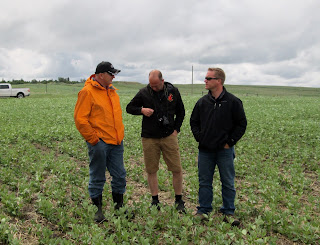A beautiful summers day in Alberta
Perfect conditions for crop inspections
Our second day with Steve, in the morning we headed out to see some crops and meet up with some of Steve's clients. After some interesting discussion about current options in the Canadian, GPS guidance market and how the problem of salinity can be addressed, we arrived at a field of Canola. Steve has been comparing conventional air seeder planted canola and using a precision vacuum planter. The conventional plot had been planted at a seedrate of 5kg/ha, which led to a plant count of 50 plants/m2, which was a 45% seed mortality rate. Therefore nearly half the seed didn't grow, for a number of reasons, seed placement, crop competition or maybe mechanical damage.
Conventional Air Seeder
The precision vacuum planter seedrate was 3.5 kg/ha, which led to a plant count of 65 plants/m2 and a 7% seed mortality. This is a much lower seed mortality, and means that the seed rate could probably be reduced some more, and still give an adequate plant count and good crop canopy density, at the same time as reducing the seed cost. This method does require a specialist drill for the canola though, so it is not all positive, that's farming for you! The vast majority of Canola grown in Canada is GM, and is made up around 100 different varieties which fall into 3 distinct herbicide tolerant groups (Roundup Ready, Clearfield and Liberty Link). Along with the herbicide tolerance other growth traits are built into the GM breeding such as drought and heat tolerance, maturity date and stem stiffness.
After inspecting the canola trial we met up with one of Steve's clients, Allen Jones. Al was farming around 5000 acres and growing wheat, canola and for the first year Faba Beans, which were just starting to flower to our surprise.
Looks like Al, Jake and Steve are deep in thought
inspecting Al's new crop of Faba Beans
Al also has a herd of 200 Hereford (Herfud, as the Canadians like to pronounce it!) cattle, we didn't get to see them unfortunately. The cattle are all kept outside all year round, and Al has designed a straw and chaff collector that fits on the back of his combine. When the collector is full it tips the straw and chaff out in piles, then during the winter the cattle feed on it, seems like a good way to deal with the crop residue and feed cattle outside.
After lunch we meet some more of Steve's clients along with some representatives from Bayer in a local bar, I think I could get used to agronomy in Alberta. We chatted about the different fungicide programs in the UK and Canada. Stobilurins are still widely used in Canada, as there is little resistance to them unlike the UK, Triazoles are also commonly used. At the moment no SDHI fungicides are used in Canada. No Growth regulators are used at the moment either but, interest is growing as Canadian farmers are trying to increase yields without having lodging issues.
At the end of the day we visited another farm belonging to the Hilton Family, near Strathmore.
We met Spencer Hilton and his son Dane, who had only recently come back to the family business. The Hiltons had land that was very spread out and was 100km from end to end, but with large roads and not too much traffic the distance is manageable and sometimes an advantage if the weather is stormy. The Hiltons ran a very efficient business and were geared to allow opportunities for younger members of the family to join if they wanted to. We even got to drink some beer made in California with their barley whilst we talked farming and Nuffield.




No comments:
Post a Comment